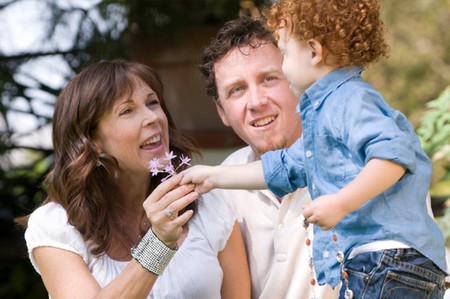A young child usually takes great delight in the sort of habits that adults regard as bad manners: first, because they usually ease feelings of discomfort, and second, because of the response that greets them.
Belching and farting are guaranteed to raise a laugh, spitting out half-chewed food causes onlookers to squirm, and nose-picking (and flicking) makes others feel sick. Elicits a response, doesn’t it? Other examples of bad manners, such as interrupting a conversation or barging to the front of the line also ensure that the child gets what he wants.
Consistently displaying bad manners will, in the long run, have two psychological effects:
• The child will become unpopular. Of course, the child will get a laugh from others at first. We’ve all seen a group of young children burst into squeals of delight when one of them breaks wind. Eventually, the joke wears off, and others won’t want to sit beside him because they think he is disgusting. And a child who constantly pushes others out of the way is unlikely to be liked.
• The child himself will feel uncomfortable. He’ll be following one set of social rules while everybody else is following another. Suppose you tried to play soccer when everyone else was using the ball for volleyball. You’d feel strange because you’d be aware that what you were doing wasn’t in harmony with those around you. This is the sort of feeling a bad-mannered child will experience.
Children don’t start out in life fascinated by habits that adults regard as “bad manners.” A baby does these things with complete indifference: he passes gas without embarrassment, he explores his body cavities quite naturally, and he shouts out when he wants something. These habits are normal, from the child’s point of view. His parents encourage most of them because they know he feels more comfortable afterwards.
Adult perceptions change as a child matures, however. What was considered acceptable from a baby is no longer endearing when the child reaches toddler or preschool stage. Adults expect an older child to have greater understanding of the world around him and to be more aware of social conventions. A child’s perception also changes. Somewhere between birth and the next five years, the child begins to realize that adults consider some behavior to be “good manners,” although he doesn’t know precisely how this distinction is made.
Later on, the child will discover that many of these rules are only a matter of social convention, and that they are not universal. He’ll also learn that some aspects of good manners are yery subtle. Some people, for instance, think that it is good manners to leave a small amount of food on their dinner plate, because that lets their hosts know that they’ve had enough to eat; other people think it is bad manners to leave food on the plate because it suggests to their hosts that the meal was not tasty enough to finish. You have to learn to read each situation.
In the meantime your child becomes aware that adults start to frown when he makes a “rude” noise during mealtimes. Or he is reprimanded for picking his nose while watching television. That’s the exact point when he becomes fascinated by these habits. Tell your child not to do something—particularly if you don’t give him a good reason why not—and you can be sure he’ll do it again. The more you giggle when your child passes wind, the more he will continue to do so. Children do find these habits intrinsically enjoyable, just as adults do, because in most cases they do relieve a feeling of physical discomfort. But it is certainly not the habits per se that fascinate the children; it’s the adults’ reaction to them that give children such joy.
If you want to discourage your child from persisting with actions that you regard as bad manners, do the following:
- Set a good example yourself. You can hardly expect your child to stop picking wax out of his ear, if he sees you mindlessly drilling deep into the side of your own head. Make sure you do not ask your child to follow a set of rules that he knows you ignore.
- Don’t laugh at your child’s behavior. Once your child thinks you regard his behavior as funny, you will have a hard time convincing him otherwise. Better to discourage it right from the start.
- Keep things in perspective. Chances are, some of your child’s bad manners will make you feel genuinely disgusted. By all means use a firm voice and a scowl to indicate your displeasure; but try not to be extreme. A balanced reaction works better.
- Use meaningful explanations. Tell your child why you think good manners are important, and be very explicit about the benefits of being well mannered. Always use explanations that your child can understand (for example, “You won’t get invited to parties if you pick the icing off the cake.”).
- Reinforce good manners. Praising your child for behaving well will encourage him to repeat the behavior. So let your child know that you are pleased with him for showing good manners. Make your comments quite specific and clear. “I was so proud when you waited quietly for your turn.”
Categories
Advertisements
Recent Articles
 How to Understand Bed Sizes – A Small Guide
How to Understand Bed Sizes – A Small Guide How to Select Some Must Have Kitchen Accessories
How to Select Some Must Have Kitchen Accessories Best Way to Change a Car Tire
Best Way to Change a Car Tire Best Way to Write an Affirmation
Best Way to Write an Affirmation Best Way to Take Charge of Your Financial Life
Best Way to Take Charge of Your Financial Life Best Way to Survive a Party When You Don’t Know Anyone
Best Way to Survive a Party When You Don’t Know Anyone Best Way to Stop Self Sabotaging Yourself
Best Way to Stop Self Sabotaging Yourself Best Way to Start Journal Writing
Best Way to Start Journal Writing Best Way to Speak with a Powerful Voice
Best Way to Speak with a Powerful Voice Best Way to Simplify Your Life
Best Way to Simplify Your Life Best Way to Respond to a Put-Down
Best Way to Respond to a Put-Down Best Way to Reduce Acne Breakouts
Best Way to Reduce Acne Breakouts Best Way to Recover from Dining Disasters
Best Way to Recover from Dining Disasters Best Way to Quit Your Job Gracefully
Best Way to Quit Your Job Gracefully Best Way to Make Your Own Website
Best Way to Make Your Own Website




Leave a Reply